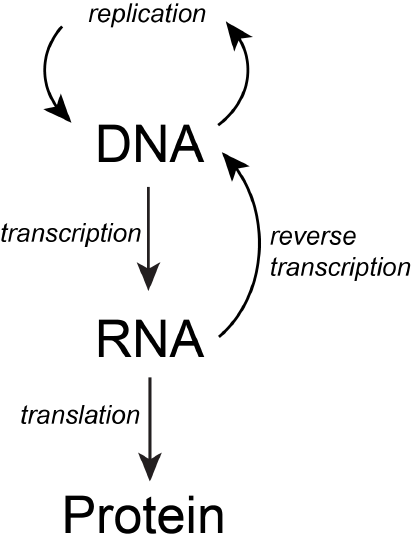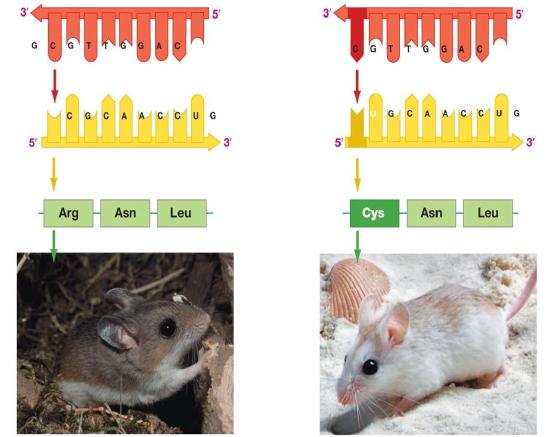Winter_2024_Bis2A_Facciotti_Reading_20
- Page ID
- 122800
\( \newcommand{\vecs}[1]{\overset { \scriptstyle \rightharpoonup} {\mathbf{#1}} } \)
\( \newcommand{\vecd}[1]{\overset{-\!-\!\rightharpoonup}{\vphantom{a}\smash {#1}}} \)
\( \newcommand{\id}{\mathrm{id}}\) \( \newcommand{\Span}{\mathrm{span}}\)
( \newcommand{\kernel}{\mathrm{null}\,}\) \( \newcommand{\range}{\mathrm{range}\,}\)
\( \newcommand{\RealPart}{\mathrm{Re}}\) \( \newcommand{\ImaginaryPart}{\mathrm{Im}}\)
\( \newcommand{\Argument}{\mathrm{Arg}}\) \( \newcommand{\norm}[1]{\| #1 \|}\)
\( \newcommand{\inner}[2]{\langle #1, #2 \rangle}\)
\( \newcommand{\Span}{\mathrm{span}}\)
\( \newcommand{\id}{\mathrm{id}}\)
\( \newcommand{\Span}{\mathrm{span}}\)
\( \newcommand{\kernel}{\mathrm{null}\,}\)
\( \newcommand{\range}{\mathrm{range}\,}\)
\( \newcommand{\RealPart}{\mathrm{Re}}\)
\( \newcommand{\ImaginaryPart}{\mathrm{Im}}\)
\( \newcommand{\Argument}{\mathrm{Arg}}\)
\( \newcommand{\norm}[1]{\| #1 \|}\)
\( \newcommand{\inner}[2]{\langle #1, #2 \rangle}\)
\( \newcommand{\Span}{\mathrm{span}}\) \( \newcommand{\AA}{\unicode[.8,0]{x212B}}\)
\( \newcommand{\vectorA}[1]{\vec{#1}} % arrow\)
\( \newcommand{\vectorAt}[1]{\vec{\text{#1}}} % arrow\)
\( \newcommand{\vectorB}[1]{\overset { \scriptstyle \rightharpoonup} {\mathbf{#1}} } \)
\( \newcommand{\vectorC}[1]{\textbf{#1}} \)
\( \newcommand{\vectorD}[1]{\overrightarrow{#1}} \)
\( \newcommand{\vectorDt}[1]{\overrightarrow{\text{#1}}} \)
\( \newcommand{\vectE}[1]{\overset{-\!-\!\rightharpoonup}{\vphantom{a}\smash{\mathbf {#1}}}} \)
\( \newcommand{\vecs}[1]{\overset { \scriptstyle \rightharpoonup} {\mathbf{#1}} } \)
\( \newcommand{\vecd}[1]{\overset{-\!-\!\rightharpoonup}{\vphantom{a}\smash {#1}}} \)
Learning Objectives Associated with Winter_2024_Bis2a_Facciotti_Reading_20
GI.40 Describe the key components of the central dogma and the relationships between them, including the processes of replication, transcription, translation, reverse transcription and the possible fates of the various possible products (i.e. mRNA, tRNA, rRNA, enzymes, structural proteins, replicated chromosomes etc.). GI.22 Create illustrations that model the structures of RNA. These should span several levels of detail and abstraction that include cartoon models of: (a) three nucleotides and their phosphodiester bonds; (b) a zoomed-out representation of an mRNA and a tRNA. GI.3 Given an abstracted model of a genomic region, correctly interpret representations of genes, promoters, and other functional elements that are represented as geometric objects, abstract representations of DNA sequences, on the linear genome coordinate. GI.17 Create a model for a basic transcriptional unit that includes promoters, transcriptional regulatory sites for transcription factor binding, ribosome binding site, coding region, stop codon and transcriptional terminator. GI.18 Use the model of a transcriptional unit to discuss the roles of each of the structural elements of a transcriptional unit. Identify those that are transcribed, those that may be translated and those that serve other roles. GI.21 Create a dynamic model (verbal, drawing, etc.) of the process of transcription that includes the reactants, products, enzymes, the sites on the DNA required for transcription to take place, and how these components interact with the DNA template at different times during the process. Put GI.17 and GI.18 into action! |
The flow of genetic information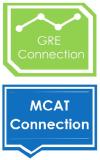
In bacteria, archaea, and eukaryotes, the primary role of DNA is to store heritable information that encodes the instruction set required for creating the organism in question. While we have gotten much better at quickly reading the chemical composition (the sequence of nucleotides in a genome and some chemical modifications that are made to it), we still don't know how to decode reliably all the information within and all the mechanisms by which it is read and ultimately expressed.
There are, however, some core principles and mechanisms associated with the reading and expression of the genetic code whose basic steps are understood and that need to be part of the conceptual toolkit for all biologists. Two of these processes are transcription and translation, which are the coping of parts of the genetic code written in DNA into molecules of the related polymer RNA and the reading and encoding of the RNA code into proteins, respectively.
In BIS2A, we focus on developing an understanding of the process of transcription (recall that an Energy Story is a rubric for describing a process) and its role in the expression of genetic information. We motivate our discussion of transcription by focusing on functional problems (bringing in parts of our problem solving/design challenge rubric) that must be solved the process to take place. We then describe how the process is used by Nature to create a variety of functional RNA molecules (that may have various structural, catalytic or regulatory roles) including so called messenger RNA (mRNA) molecules that carry the information required to synthesize proteins. Likewise, we focus on challenges and questions associated with the process of translation, the process by which the ribosomes synthesize proteins.
We often depict the basic flow of genetic information in biological systems in a scheme known as "the central dogma" (see figure below). This scheme states that information encoded in DNA flows into RNA via transcription and ultimately translated to proteins. Processes like reverse transcription (the creation of DNA from and RNA template) and replication also represent mechanisms for propagating information in different forms. This scheme, however, says nothing per se about how information is encoded or about the mechanisms by which regulatory signals move between the various layers of molecule types depicted in the model. Therefore, while the scheme below is a nearly required part of the lexicon of any biologist, perhaps left over from old tradition, students should also know mechanisms of information flow are more complex (we'll learn about some as we go, and that "the central dogma" only represents some core pathways).
Figure 1. The flow of genetic information. Attribution: Marc T. Facciotti (original work)
Genotype to phenotype
An important concept in the following sections is the relationship between genetic information, the genotype, and the result of expressing it, the phenotype. These two terms and the mechanisms that link the two will be discussed repeatedly over the next few weeks—start becoming proficient with using this vocabulary.
Figure 2. Information in DNA that will be expressed by transcription is stored in the sequence of individual nucleotides read in the 5' to 3' direction. Conversion of the information from DNA into RNA (a process called transcription) expresses that information into a temporary copy that can be functional as is (e.g. tRNA, rRNA), or a message encoding the information required to build a protein (e.g. mRNA). Cells use the mRNA as the template for the creation proteins via translation. Here, we show two different DNA sequences. The differences in each DNA sequence result in the production of two different mRNAs, followed by the synthesis of two different proteins. Ultimately, these different proteins create two different coat colors in the mice.
Genotype refers to the information stored in the DNA of the organism, the sequence of the nucleotides, and the compilation of its genes. Phenotype refers to any physical characteristic that you can measure, such as height, weight, amount of ATP produced, ability to metabolize lactose, and response to environmental stimuli. Differences in genotype, even slight, can lead to different phenotypes subject to natural selection. The figure above depicts this idea. Also note that, while we talk classically about the genotype and phenotype relationship in the context of multicellular organisms, this nomenclature and the underlying concepts apply to all organisms, even single-celled organisms like bacteria and archaea.
Genes
What is a gene? A gene is a segment of DNA in an organism's genome that encodes a functional RNA (such as rRNA, tRNA, etc.) or protein product (enzymes, tubulin, etc.). A generic gene contains elements encoding regulatory regions and a region encoding a transcribed unit.
Genes can gain mutations—defined as changes in the composition and or sequence of the nucleotides—either in the coding or regulatory regions. These mutations can lead to several outcomes: (1) nothing measurable happens as a result; (2) the gene is no longer expressed; or (3) the expression or behavior of the gene product(s) are different. In a population of organisms sharing the same gene different variants of the gene are known as alleles. Different alleles can lead to differences in phenotypes of individuals and contribute to the diversity in biology under selective pressure.
Start learning these vocabulary terms and associated concepts. You will then be somewhat familiar with them when we dive into them in more detail over the next lectures.
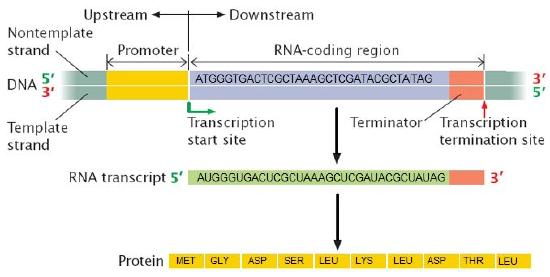
Figure 3. A gene consists of a coding region for an RNA or protein product accompanied by its regulatory regions. The coding region is transcribed into RNA which is then translated into protein.
Transcription from DNA to RNA
Bacteria, archaea, and eukaryotes must all transcribe genes from their genomes. While the cellular location may be different (eukaryotes perform transcription in the nucleus; bacteria and archaea perform transcription in the cytoplasm), the mechanisms by which organisms from each of these clades carry out this process are fundamentally the same and can be characterized by three stages: initiation, elongation, and termination.
A short overview of transcription
Transcription is the process of creating an RNA copy of a segment of DNA. Since this is a process, we want to apply the Energy Story rubric to develop a functional understanding of transcription. What does the system of molecules look like before the start of the transcription? What does it look like at the end? What transformations of matter and transfers of energy happen during the transcription, and what catalyzes the process? We also want to think about the process from a Design Challenge standpoint. If the biological task is to create a copy of DNA in the chemical language of RNA, what challenges can we reasonably hypothesize or expect, given our knowledge about other nucleotide polymer processes, must be overcome? Is there evidence that Nature solved these problems in different ways? What seem to be the criteria for the success of transcription? You get the idea.
Listing some basic requirements for transcription
Let us first consider the tasks at hand by using some of our foundational knowledge and imagining what might need to happen during transcription if the goal is to make an RNA copy of a piece of one strand of a double-stranded DNA molecule. We'll see that using some basic logic allows us to infer many of the important questions and things that we need to know in order to describe the process properly.
Let us imagine that we want to design a nanomachine/nanobot that would conduct transcription. We can use some Design Challenge thinking to identify problems and subproblems that need to be solved by our little robot.
• Where should the machine start? Along the millions to billions of base pairs, where should the machine be directed?
• Where should the machine stop?
• If we have start and stop sites, we will need ways of encoding that information so that our machine(s) can read this information—how will that be accomplished?
• How many RNA copies of the DNA will we need to make?
• How fast do the RNA copies need to be made?
• How accurately do the copies need to be made?
• How much energy will the process take and where is the energy going to come from?
These are only some core questions. One can dig deeper if they wish. However, these are already good enough for us to get a good feel for this process. Notice, too, that many of these questions are remarkably similar to those we inferred might be necessary to understand DNA replication.
The building blocks of transcription
The building blocks of RNA
Recall from our discussion on the structure of nucleotides that the building blocks of RNA are very similar to those in DNA. In RNA, the building blocks comprise nucleotide triphosphates that are composed of a ribose sugar, a nitrogenous base, and three phosphate groups. The key differences between the building blocks of DNA and those of RNA are that RNA molecules are composed of nucleotides with ribose sugars (as opposed to deoxyribose sugars) and use uridine, a uracil containing nucleotide (as opposed to thymidine in DNA). Note below that uracil and thymine are structurally very similar—the uracil is just lacking a methyl (CH3) functional group compared to thymine.

Figure 1. The basic chemical components of nucleotides. Attribution: Marc T. Facciotti (original work)
Transcription initiation
Promoters
Proteins responsible for creating an RNA copy of a specific piece of DNA (transcription) must first be able to recognize the beginning of the element to be copied. A promoter is a DNA sequence onto which various proteins, collectively known as the transcription machinery, bind and start transcription. In most cases, promoters exist upstream (5' to the coding region) of the genes they regulate. The specific sequence of a promoter is very important because it determines whether the cell transcribes the corresponding coding portion of the gene all the time, sometimes, or infrequently. Although promoters vary among species, a few elements of similar sequences are sometimes conserved. At the -10 and -35 regions upstream of the initiation site, there are two promoter consensus sequences, or regions similar across many promoters and across various species. Some promoters will have a sequence very similar to the consensus sequence (the sequence containing the most common sequence elements), and others will look very different. These sequence variations affect the strength to which the transcriptional machinery can bind to the promoter to start transcription. This helps to control the number of transcripts that are made and how often they get made.
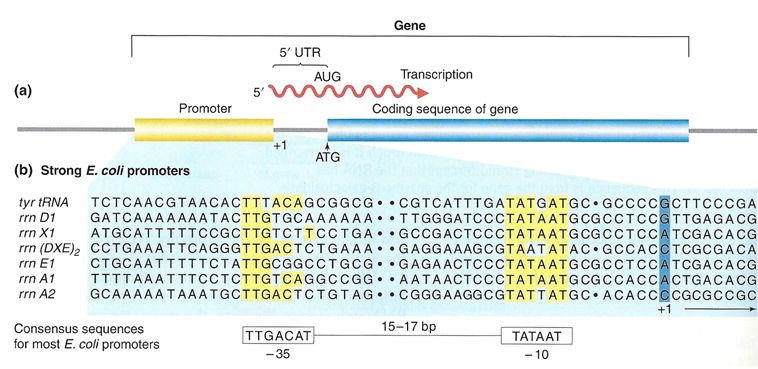
Figure 2. (a) A general diagram of a gene. The gene includes the promoter sequence, an untranslated region (UTR), and the coding sequence. (b) A list of several strong E. coli promoter sequences. The -35 box and -10 box are highly conserved sequences throughout the strong promoter list. Weaker promoters will have more base pair differences when compared to these sequences. Source: http://www.discoveryandinnovation.co...lecture12.html
Bacterial vs. eukaryotic promoters
In bacterial cells, the -10 consensus sequence, called the -10 region, is AT rich, often TATAAT. The -35 sequence, TTGACA, is recognized and bound by the protein σ. Once this protein-DNA interaction is made, the subunits of the core RNA polymerase bind to the site. Because of the relatively lower stability of AT associations, the AT-rich -10 region facilitates unwinding of the DNA template, and several phosphodiester bonds are made.
Eukaryotic promoters are much larger and more complex than prokaryotic promoters, but both have an AT-rich region—in eukaryotes, it is typically called a TATA box. For example, in the mouse thymidine kinase gene, the TATA box is located at approximately -30. For this gene, the exact TATA box sequence is TATAAAA, as read in the 5' to 3' direction on the nontemplate strand. This sequence is not identical to the E. coli -10 region, but both share the quality of being AT-rich element.
Instead of a single bacterial polymerase, the genomes of most eukaryotes encode three different RNA polymerases, each made up of ten protein subunits or more. Each eukaryotic polymerase also requires a distinct set of proteins known as transcription factors to recruit it to a promoter. In addition, an army of other transcription factors, proteins known as enhancers, and silencers help to regulate the synthesis of RNA from each promoter. Enhancers and silencers affect the efficiency of transcription but are not necessary for the initiation of transcription or its procession. Basal transcription factors are crucial in the formation of a preinitiation complex on the DNA template that subsequently recruits RNA polymerase for transcription initiation.
The initiation of transcription begins with the binding of RNA polymerase to the promoter. Transcription requires the DNA double helix to partially unwind such that one strand can be used as the template for RNA synthesis. The region of unwinding is called a transcription bubble.
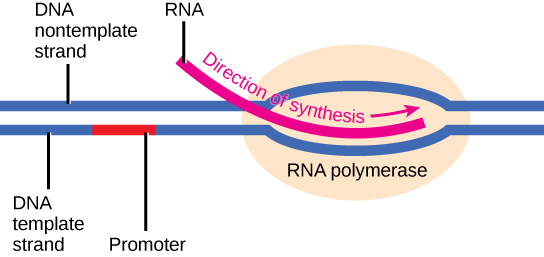
Figure 3. During elongation, RNA polymerase tracks along the DNA template, synthesizes mRNA in the 5' to 3' direction, and unwinds then rewinds the DNA as it is read.
Elongation
Transcription always proceeds from the template strand, one of the two strands of the double-stranded DNA. The RNA product is complementary to the template strand and is almost identical to the nontemplate strand, called the coding strand, with the exception that RNA contains a uracil (U) in place of the thymine (T) found in DNA. During elongation, an enzyme called RNA polymerase proceeds along the DNA template, adding nucleotides by base pairing with the DNA template in a manner similar to DNA replication, with the difference being an RNA strand that is synthesized does not remain bound to the DNA template. As elongation proceeds, the DNA is continuously unwound ahead of the core enzyme and rewound behind it. Note that the direction of synthesis is identical to that of synthesis in DNA—5' to 3'.
Figure 4. During elongation, RNA polymerase tracks along the DNA template, synthesizing mRNA in the 5' to 3' direction, unwinding and then rewinding the DNA as it is read.
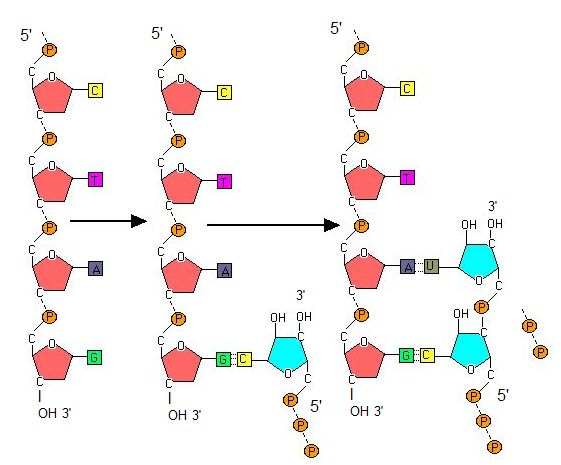
Figure 5. The addition of nucleotides during the process of transcription is very similar to nucleotide addition in DNA replication. The RNA is polymerized from 5' to 3', and with each addition of a nucleotide, a phosphoanhidride bond is hydrolized by the enzyme, resulting in a longer polymer and the release of two inorganic phosphates. Source: http://utminers.utep.edu/rwebb/html/...longation.html
Bacterial vs. eukaryotic elongation
In bacteria, elongation begins with the release of the σ subunit from the polymerase. The dissociation of σ allows the core enzyme to proceed along the DNA template, synthesizing mRNA in the 5' to 3' direction at a rate of approximately 40 nucleotides per second. As elongation proceeds, the DNA is continuously unwound ahead of the core enzyme and rewound behind it. The base pairing between DNA and RNA is not stable enough to maintain the stability of the mRNA synthesis components. Instead, the RNA polymerase acts as a stable linker between the DNA template and the nascent RNA strands to ensure that elongation is not interrupted prematurely.
In eukaryotes, following the formation of the preinitiation complex, the polymerase is released from the other transcription factors, and elongation is allowed to proceed as it does in prokaryotes with the polymerase synthesizing pre-mRNA in the 5' to 3' direction. As discussed previously, RNA polymerase II transcribes the major share of eukaryotic genes, so this section will focus on how this polymerase accomplishes elongation and termination.
Possible NB Discussion  Point
Point
Compare and contrast the energy story for DNA replication initiation + elongation to the energy story for transcription initiation + elongation.
Termination
In bacteria
Once a gene is transcribed, the bacterial polymerase needs to dissociate from the DNA template and liberate the newly made mRNA. Depending on the gene being transcribed, there are two kinds of termination signals. One is a protein-based, and the other is RNA-based. Rho-dependent termination is controlled by the rho protein, which tracks along the polymerase on the growing mRNA chain. Near the end of the gene, the polymerase encounters a run of G nucleotides on the DNA template and it stalls. As a result, the rho protein collides with the polymerase. The interaction with rho releases the mRNA from the transcription bubble.
Rho-independent termination is controlled by specific sequences in the DNA template strand. As the polymerase nears the end of the gene being transcribed, it encounters a region rich in CG nucleotides. The mRNA folds back on itself, and the complementary CG nucleotides bind together. The result is a stable hairpin that causes the polymerase to stall as soon as it begins to transcribe a region rich in AT nucleotides. The complementary UA region of the mRNA transcript forms only a weak interaction with the template DNA. This, coupled with the stalled polymerase, induces enough instability for the core enzyme to break away and liberate the new mRNA transcript.
In eukaryotes
The termination of transcription is different for the different polymerases. Unlike in prokaryotes, elongation by RNA polymerase II in eukaryotes takes place 1,000–2,000 nucleotides beyond the end of the gene being transcribed. This pre-mRNA tail is subsequently removed by cleavage during mRNA processing. On the other hand, RNA polymerases I and III require termination signals. Genes transcribed by RNA polymerase I contain a specific 18-nucleotide sequence that is recognized by a termination protein. The process of termination in RNA polymerase III involves a mRNA hairpin similar to rho-independent termination of transcription in prokaryotes.
In archaea
Termination of transcription in the archaea is far less studied than in the other two domains of life and is still not well understood. While the functional details are likely to resemble mechanisms that have been seen in the other domains of life, the details are beyond the scope of this course.
Cellular location
In bacteria and archaea
In bacteria and archaea, transcription occurs in the cytoplasm, where the DNA is located. Because the location of the DNA, and thus the process of transcription, are not physically segregated from the rest of the cell, translation often starts before transcription has finished. This means that mRNA in bacteria and archaea is used as the template for a protein before it produces the entire mRNA. The lack of spatial segregation also means that there is very little temporal segregation for these processes. Figure 6 shows the processes of transcription and translation occurring simultaneously.
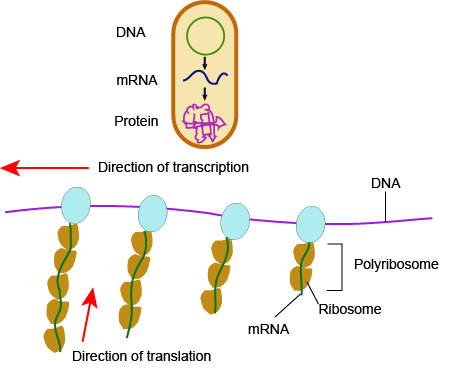
Figure 6. The addition of nucleotides during the process of transcription is very similar to nucleotide addition in DNA replication.
Source: Marc T. Facciotti (own work)
In eukaryotes....
In eukaryotes, the process of transcription is physically segregated from the rest of the cell, sequestered inside of the nucleus. This results in two things: the mRNA is completed before translation can start, and there is time to "adjust" or "edit" the mRNA before translation starts. The physical separation of these processes gives eukaryotes a chance to alter the mRNA in such a way as to extend the lifespan of the mRNA or even alter the protein product that will be produced from the mRNA.
mRNA processing
5' G-cap and 3' poly-A tail
When an eukaryotic gene is transcribed, the cell processes the primary transcript in the nucleus in several ways. Eukaryotic cells modify mRNAs at the 3' end by the addition of a poly-A tail. This run of A residue is added by an enzyme that does not use genomic DNA as a template. The mRNAs have a chemical modification of the 5' end, called a 5'-cap. Data suggests that these modifications both help to increase the lifespan of the mRNA (prevent its premature degradation in the cytoplasm) and to help the mRNA start translation.
Figure 7. pre-mRNAs are processed in a series of steps. Introns are removed, a 5' cap and poly-A tail are added. Source: http://www.discoveryandinnovation.co...lecture12.html
Possible NB Discussion  Point
Point
Transcriptomics is a branch of “-omics” that involves studying an organism or population’s transcriptome or, the complete set of all RNA molecules. What kind of information can you obtain from studying the transcriptome(s)? Can you think of any cool scientific questions that a transcriptomic analysis might help resolve? What are some constraints to transcriptomic approaches one might keep in mind when conducting analyses?
Alternative splicing
Splicing occurs on most eukaryotic mRNAs in which introns are removed from the mRNA sequence and exons are ligated together. This can create a much shorter mRNA than initially transcribed. Splicing allows cells to mix and match which exons are incorporated into the final mRNA product. As shown in the figure below, this can lead to multiple proteins being coded for by a single gene.
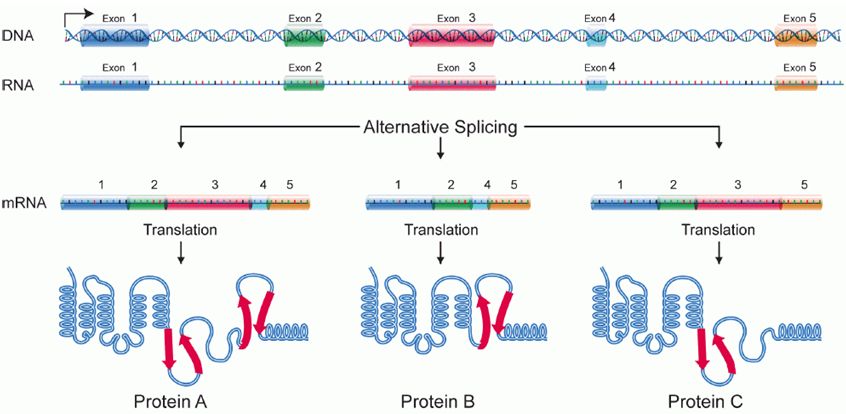
Figure 8. The information stored in the DNA is finite. In some cases, organisms can mix and match this information to create different end products. In eukaryotes, alternative splicing allows for the creation of different mRNA products, which in turn are used in translation to create different protein sequences. This ultimately leads to the production of different protein shapes, and thus different protein functions.
Source: http://www.discoveryandinnovation.co...lecture12.html
POST PRACTICE GUIDE
General Practice
3. Why: RNA is a chemical cousin of DNA and the first product of gene expression that can take on many different important roles in the cell. Here we review the basics and build mental pictures of what the core structure looks like and how polymers of RNA can take different forms.
How to practice: Review the chemical and structural similarities between DNA and RNA by creating figures associated with learning goal: “Create illustrations that serve as models of your understanding of the three dimensional structures of RNA. These should span several levels of detail and abstraction that include cartoon models of: (a) Three nucleotides and their phosphodiester bonds. (b) A zoomed out representation of an mRNA and a tRNA.”
This exercise helps you practice learning objectives: GI.22 Create illustrations that model the structures of RNA. These should span several levels of detail and abstraction that include cartoon models of: (a) three nucleotides and their phosphodiester bonds; (b) a zoomed-out representation of an mRNA and a tRNA.
4. Why: The process of transcription is central to the expression of genetic information. Here we encourage you to practice seeing this process in the context of other processes involved in the central dogma, directing the roles of key players and, importantly, again suggesting that you work to connect lessons about this process to all of the lessons that have come from class - from day 1 to the lecture before this one. Nearly every lecture in the course can be not to distantly linked to how we can understand transcription.
How to practice: In class we showed a figure that associated the central dogma (DNA -> RNA -> protein). Go back to the figure of a cell that you have been creating off and on. Can you add these new processes? Now try to relate these new processes (replication, transcription, translation) with the material from the previous two midterms. For instance, where have we seen proteins functioning? Can you create a figure that relates replication, transcription, translation to central metabolism?
It’s one thing (and a very necessary thing) to know the steps involved in the expression of genetic information. But it is equally - if not more - important to understand the significance of this process by functionally and conceptually linking this process to many of the other lessons we talked about in class this quarter. Once you have your figure ready, try to use it to wow your roommate(s) with a tour of the cell and see if you can use the figure to help “explain” out loud and with appropriate use of vocabulary what you’ve drawn. Try to find at least one cool thing to point out to them. The exercises of (a) drawing the concept from memory and (b) trying to verbally explain what you’ve done are both great “self-testing” mechanisms. You’ll know if you’re struggling or if you got it down by listening to yourself or by how reliant you are on external resources to make a complete picture.
This exercise helps you practice learning objectives: GI.40 Describe the key components of the central dogma and the relationships between them, including the processes of replication, transcription, translation, reverse transcription and the possible fates of the various possible products (i.e. mRNA, tRNA, rRNA, enzymes, structural proteins, replicated chromosomes etc.).
5. Why: Being able to visualize a model for the process of transcription can help you to understand it better and to think about how it can go wrong. Here we make suggestions on how to help build that model by walking through the creation of an image that can serve to be a skeleton for your own model. We try to link parts, functions, problems, tradeoffs together and the whole story to prior concepts learned for DNA replication to help build mental associations between topics.
How to practice: Yup! It’s a sketching heavy study guide. Here I will prompt you to revisit the design challenge associated with making a transcript. If you like, and since you’ve seen this already once in discussion, try this before Monday’s lecture.
First: Try to imagine that you are an RNA Polymerase approaching a stretch of double stranded DNA. What are the mechanistic challenges you face as you try to transcribe some RNA? Make a list of these challenges (or subproblems of the “big” transcription problem).
Second: Create a figure that depicts the important components involved in transcription initiation, elongation, and termination. Link each of the elements in your figure to the list of challenges/subproblems that must be addressed.
Third: For each of the solutions try as best you can to evaluate (a) possible alternate ways of achieving the same outcome and (b) what do your original and Nature’s solutions have as trade-offs?
Fourth: Compare your sketches of transcription to sketches you made of DNA replication. Can you see the similarities? Do the sketches help you pick out some of the key differences?
This exercise helps you practice learning objectives: GI.3 Given an abstracted model of a genomic region, correctly interpret representations of genes, promoters, and other functional elements that are represented as geometric objects, abstract representations of DNA sequences, on the linear genome coordinate.; GI.17 Create a model for a basic transcriptional unit that includes promoters, transcriptional regulatory sites for transcription factor binding, ribosome binding site, coding region, stop codon and transcriptional terminator.; GI.18 Use the model of a transcriptional unit to discuss the roles of each of the structural elements of a transcriptional unit. Identify those that are transcribed, those that may be translated and those that serve other roles.
6. Why: The promoter is a special sequence in transcription. Here we ask you to think about how its structure may influence its function and interactions with RNA Polymerase. It also encourages you to think about how proteins might recognize specific DNA sequences and what you know about base pairing between two strands of DNA may play a role in the function of a promoter.
How to practice: For transcription to begin, RNA polymerase must binds to the promoter. This tells the RNA polymerase not only where to start but also tells the RNA polymerase which strand to transcribe. What are the characteristics of the DNA sequence of the promoter that provide this information?
This exercise helps you practice learning objectives: GI.18 Use the model of a transcriptional unit to discuss the roles of each of the structural elements of a transcriptional unit. Identify those that are transcribed, those that may be translated and those that serve other roles.
7. Why: The structure of the promoter is important in regulation the expression of genes. We’ll talk about this soon but for now this primes you for that topic and gets you thinking more about the nature of molecular interactions that occur between proteins and DNA, in this case RNA polymerases and promoters.
How to practice: The figure below shows three different promoter sequences that are specifically recognized by three different RNA polymerases that carry different sigma factors (proteins that help recruit RNA polymerase to the promoter). We will discuss this topic in more detail when we discuss transcription regulation. In the meantime, the purpose for introducing it here is to illustrate the asymmetric nature of promoters. Can you see how the information in the DNA sequence would allow the three RNA polymerases to initiate transcription from their own promoters and not from other promoters?

This exercise helps you practice learning objectives: GI.18 Use the model of a transcriptional unit to discuss the roles of each of the structural elements of a transcriptional unit. Identify those that are transcribed, those that may be translated and those that serve other roles.
8. Why: DNA and RNA polymerases catalyze similar reactions - they both string nucleotides together into chains. However, these two types of enzymes have different qualities beyond their specific choice of nucleotides that are important in the contexts of the different roles they play. As you think of this conundrum try to root yourself in what the basic biological functions are of replication and transcription - this will shed light on why the enzymes responsible for these processes behave differently.
How to practice: Given the following information:
The error rate in transcription is ~ 10-4 without proofreading and 10-6 with proofreading
By contrast: The error rate in DNA replication is ~ 10-5 without proofreading and ~10-7 with proofreading and ~10-9 including mismatch repairs.
Why is it potentially OK for transcription to have 1000x the error rate of replication
This exercise helps you practice learning objectives: Create a dynamic model (verbal, drawing, etc.) of the process of transcription that includes the reactants, products, enzymes, the sites on the DNA required for transcription to take place, and how these components interact with the DNA template at different times during the process.
9. Why: This conundrum continues the theme of exercise 8 above.
How to practice: How could the increased error rate of RNA polymerase, relative to DNA polymerase, be associated with the ability of Primase (an RNA polymerase) to initiation strand formation without a primer? Recall transcription DOES NOT require a primer but replication DOES. Is it a surprise that the primer is RNA?
This exercise helps you practice learning objectives: GI.21 Create a dynamic model (verbal, drawing, etc.) of the process of transcription that includes the reactants, products, enzymes, the sites on the DNA required for transcription to take place, and how these components interact with the DNA template at different times during the process. Put GI.17 and GI.18 into action!
10. Why: In the last two lecturers and the next we are examining three different processes, each with different enzymes, parts, and different nomenclature to go with them. Half of the challenge of learning some of the material is just keeping straight what terms, enzymes, parts, etc. go with which process. This table suggests an exercise to start getting some things associated with the proper process. Some students also like to make flash cards of this same material and similar study aids are available at various places online.
How to practice: Start to fill in the table below.
|
PROCESS |
REPLICATION |
TRANSCRIPTION |
TRANSLATION |
|
TEMPLATE
|
|
|
|
|
RESULTING POLYMER
|
|
|
|
|
MONOMERS USED
|
|
|
|
|
ENZYME(S)
|
|
|
|
|
ENERGY (+ΔG OR –ΔG)
|
|
|
|
|
ENERGY SOURCE
|
|
|
|
|
SITE TO ORIENT THE ENZYME
|
|
|
|
|
DIRECTION TO ADD MONOMERS
|
|
|
|
|
REQUIREMENTS TO CREATE THE FIRST BOND |
|
|
|
|
WHERE TO END THE PROCESS
|
|
|
|
|
HOW IMPORTANT IS FIDELITY/ACCURACY? WHY?
|
|
|
|
This exercise helps you practice learning objectives: Many learning goals from different lectures.
Practice Exam Questions
Question Q20.1
Q20.1 An mRNA has the sequence 5'-AUGAAAUCCUAG-3'. What is the template (non-coding/complementary) DNA strand for this sequence?
A. 5'-TACTTTAGGATC-3'
B. 5'-ATGAAATCCTAG-3'
C. 5'-GATCCTAAAGTA-3'
D. 5'-TACAAATCCTAG-3'
E. 5'-CTAGGATTTCAT-3'
Common variants of this type of question are to give the coding strand and ask for the transcript. Or give the strand complementary to the coding strand (template) and ask for the transcript. Or, give the transcript and ask for the coding strand. Etc. Etc. You can make up your own variants easily.
Question Q20.2
Q20.2 Since only one DNA strand is copied into mRNA to provide the information for protein synthesis why is the redundant information content of DNA so important to life?
A. Redundant information allows precise copying of information from both strands during replication and for correctly repairing damage if either strand is damaged.
B. You can transcribe either strand to get the information that encodes the amino acid sequence of one protein.
C. The redundant information in DNA eliminates the phenotypic consequences of many mutations.
D. Redundant information means that most genes are present in multiple copies even in haploids.
E. You need information from both DNA strands to dictate the amino acid sequence of a single protein.
Question Q20.3
Q20.3 Which of the following sites would you predict to be present in the gene encoding a tRNA
A. 1, 3, 2, 4
B. 1, 3, 4,
C. 1, 3, 2, 5, 6, 4
D. 1, 2, 3, 4, 5, 6
E. None of the above
LIST OF SITES
#1 Promoter
#2 Ribosome Binding Site
#3 Transcription Initiation Site
#4 Transcription Termination Site
#5 Translation Initiation Site
#6 Translation Termination Site



